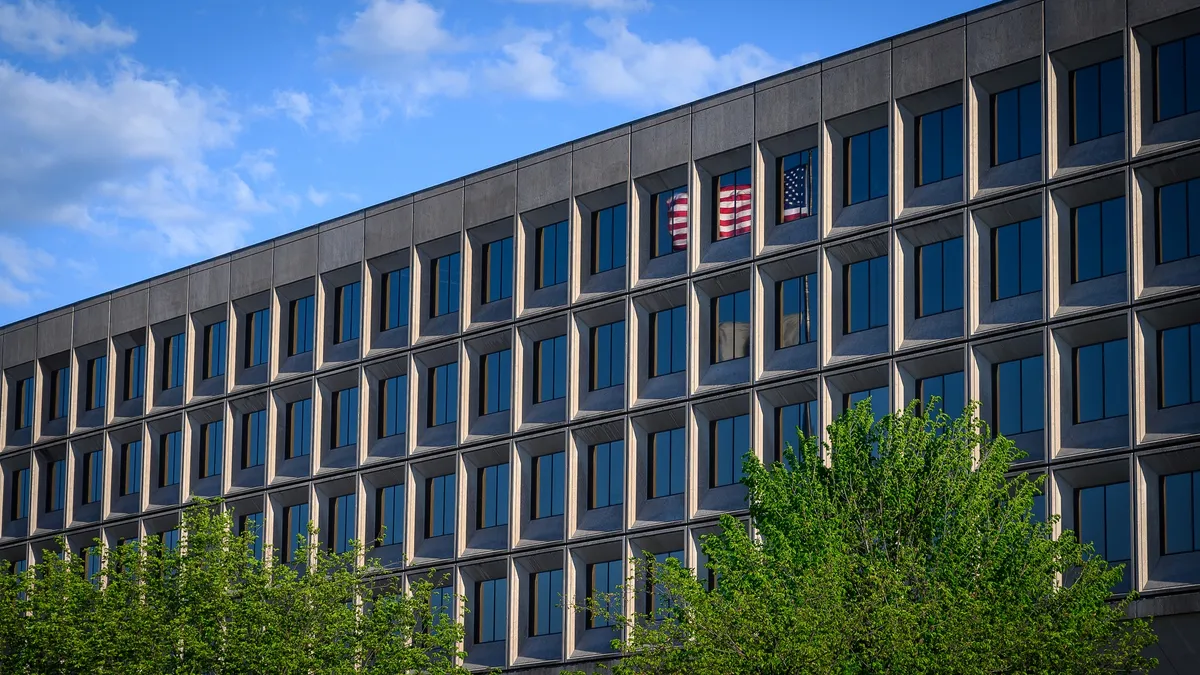Dive Brief:
- Organizations that have partnered with the U.S. Department of Energy on its Better Buildings Initiative have collectively cut costs by nearly $22 billion through efficiency improvements and emission reduction measures, according to the department’s 2024 Better Buildings Initiative Progress Report released Monday.
- These cost reductions stem from 3.6 quadrillion British thermal units of energy that have been saved since the program began in 2011. Partners have collectively cut their water use by nearly 22 billion gallons, diverted over 3.5 million tons of waste from landfills and slashed greenhouse gas emissions by more than 220 million metric tons, with financial allies extending over $37 billion for energy efficiency and renewable energy projects since then, the report says.
- In the past year, 11 organizations, including Trane Technologies, ABB, Kohl’s and California State University, reached their Better Climate Challenge goals of cutting GHG emissions by 50% in 10 years, according to DOE’s 2024 goal achievers’ list, and over 180 new successful solutions and examples have been shared in the past year as pathways for other companies to follow, per a news release Monday.
Dive Insight:
Better Buildings Initiative partners represent 28 Fortune 100 companies, 13% of all U.S. commercial building space and more than 90 state and local governments, with more than 225 partners committing to cut at least 25% of portfolio-wide GHG emissions over 10 years, per the report. This year, 26 partners achieved their goals in emissions reduction, energy and water use, waste mitigation and financing.
More than 120 partners have met their portfolio-wide energy reduction goal since the start of the program, while nearly 20 have achieved an emissions reduction goal, the report says.
More than 285 partners have pledged to reduce portfolio-wide energy use intensity by at least 20% over 10 years, with over 270 industrial partners committing to an energy use intensity reduction of at least 25% in that time, DOE says.
“We’re working with over 600 organizations with portfolio-wide goals. We want organizations to think through strategies to save money and energy at both the portfolio-wide level and at a building, plant or housing level,” said Maria Vargas, senior program advisor and director of the Better Buildings Initiative. “It’s very important for organizations to understand what their portfolios look like, how they’re using energy and the kinds of buildings they have. And second, an emissions reduction plan across their buildings…gives them clarity of focus.”
Energy efficiency remains a cornerstone of that effort, with electrification as a key area of focus for many program partners in the initial stages of their building decarbonization efforts, Vargas said. Many program partners are looking at vehicle and fleet conversions, which are part of their scope 1 and scope 2 emissions, while certain other partners are working on heat pump implementation as they navigate workforce challenges, she noted. “So, all of that is in the mix as organizations think about their decarbonization strategies,” Vargas said.
The Better Climate Challenge also provides partners with 1-on-1 technical assistance and resources to accelerate organizations’ progress in meeting GHG reduction goals. To that end, the DOE has answered more than 800 technical assistance questions for commercial and industrial partners and delivered more than 50 trainings, according to the report.
DOE launched the Framework for GHG Emissions Reduction Planning, developed in concert with over 60 organizations across multiple sectors, to help organizations develop plans for portfolio-wide decarbonization. Dozens of organizations are now using this tool and working with DOE to plan energy efficiency, electrification and renewable energy projects across their portfolios, per its news release.
To ease barriers, companies have pledged to fund energy efficiency and renewable energy projects through mechanisms such as energy performance contracts, grants, below-market loans, property assessed clean energy financing and power purchase agreements, DOE says. These financial allies include BlocPower, Budderfly, Bank of America and Hannon Armstrong Sustainable Infrastructure Capital, according to DOE. Its progress report emphasizes that close to 40 financial allies have met a financing goal.
Further, eight manufacturers and over 20 building owners and operators joined DOE’s Commercial Building Heat Pump Accelerator program to bring to market new technologies that can cut GHG emissions and energy costs by up to 50%, compared with traditional rooftop units, per the progress report. “It’s important that we get manufacturers to submit prototypes so that we can test it and make sure they work,” Vargas said. “We’re hoping to have model heat pumps available in the coming months to test.”
Meanwhile, labor shortages continue to pose a challenge for many organizations, Vargas noted. “When it comes to some of the key trades, like pipe fitters and electricians, the number of [individuals] expected to retire in the coming years is quite significant. So, a lot of our partners are being strategic and mindful of that [and] DOE is working with community colleges and other organizations that have workforce training programs to make sure that those organizations are connecting with end-users who need…work,” she said.
In the past year, more than 500 attendees joined training sessions conducted through DOE’s Better Plants program, according to its report. This program seeks to educate participants on savings opportunities and best practices to incorporate at their own facilities, while the workforce development resources available on DOE’s Better Buildings Solution Center include best practice case studies, trainings, partner presentations and outreach materials, the department says.
Interested in more facilities management news? Sign up for Facilities Dive’s newsletter today.
















